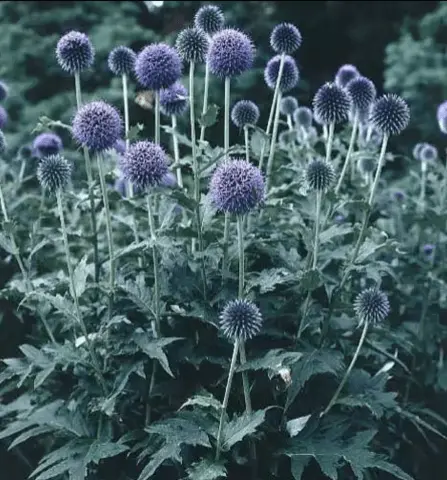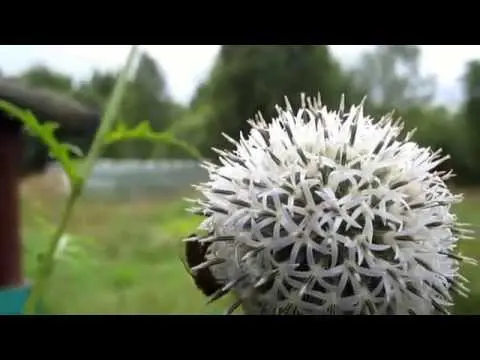Contents
The agrotechnics of the honey plant Mordovnik spherogolovogo consists in the selection of a suitable soil composition, time and technology for planting seeds. Subsequent care of the plant, including watering and fertilizing, affects the germination and honey productivity of the late summer honey plant.
Description of the plant
The herbaceous plant Mordovnik ball-headed is a representative of the Astrov family, distributed in Western Europe, the North Caucasian district, in the South, the European part of the Federation, found in Siberia and the Urals. The plant blooms in early July. Perennial Mordovnik spherogolovy refers to medicinal plants, cultivated as a honey plant. In pharmacology, it is the basis of the drug “Echinopsin”. It is used in folk medicine.
External description of the plant:
- Mordovnik grows up to 2 m in height.
- The stem is long, thin, branched upwards. Along the entire length, brown trichomes are formed, resembling a pile.
- The leaves of Mordovnik spherical are pinnately dissected with formations along the edge in the form of small spines. The plate is elongated (up to 20 cm), up to 8 cm wide, the surface is rough, the edges are carved. The color of the upper part is rich green, the lower part of the leaf plate is light gray. Leaflets grow along the entire stem in the form of a spiral, at the base the diameter is larger, towards the top it decreases, at the end point of growth the leaves are small.
- The flowers are located on the main axis, collected in a spherical, prickly inflorescence up to 400 pieces. Up to 35 inflorescences up to 6 cm in diameter are formed on the stem. Depending on the type, the flowers are white, light blue or blue in color.
- Fruits gives in the form of cylindrical achenes with a cup-shaped tuft.
- The root system is rod, in-depth.
The ball-headed Mordovnik bears fruit for the 2nd year of vegetation, the first season the plant forms a basket of long leaves, the diameter of which is about 65 cm. Flowering begins in July and continues until mid-August. The culture belongs to the honey plants of the second wave, blooming after the May and June honey plants. The flowers of Mordovnik spherogolovogo are available for bees all daylight hours, they close in the complete absence of lighting.

What types exist
Mordovnik has more than 180 species. Most of them grow like weeds on roadsides, wastelands, forest edges, and in the steppe. Mordovnik is grown in three varieties.
In addition to the ball-headed one, the ordinary Mordovnik is cultivated. This compact honey plant does not extend up more than 65 cm. The central stem and the underside of the leaf plate are covered with glandular trichomes. The color of the leaves is bright green, the same throughout the leaf, the length is 15 cm. It blooms in late summer with white inflorescences with a blue tint, 2,5 cm in diameter.
The height of Mordovnik broadleaf is approximately 80 cm. The stem is hard, thick, covered with silver-colored trichomes, looks white against the background of foliage. The leaves are long up to 25 cm, 10 cm wide, green in color. Along the edge are wide teeth ending in spines. It blooms with blue or purple flowers.
Benefits of growing as a honey plant
Cultivation of the Mordovnik plant, as a honey plant, does not require special agricultural technology. The culture tolerates fluctuations in night and daytime air temperatures well, the vegetation is not affected by the proximity of weeds. After sowing, Mordovnik spherical head needs only one top dressing. The plant is drought-resistant, can do without watering for a long time, but for greater productivity in the first year of growth, the plant needs moderate watering. Then the root system goes deep into the soil, soil moisture becomes irrelevant.
The advantage of the ball-headed Mordovnik is the release of nectar during the entire illuminated time, regardless of the weather. Honey plant blooms relatively late, is the main supplier of nectar. Flowering time is about 45 days. The spring harvest goes mainly to feed the children, and at the end of the summer there is a massive harvesting of honey for the winter, so planting the plant is economically justified. The ball-headed muzzle grows in one place for 10 years, dispersing seeds on its own and filling empty spaces.
The plant is aesthetically pleasing, harmoniously looks with flower crops on the site, complements the landscape design. It is a favorite among honey plants. It has medicinal properties, the fruits consist of active substances that are widely used in alternative medicine and pharmacology.
Application in agriculture
The ball-headed muzzle is cultivated as feed for livestock. Cutting is carried out 3 times during the summer-autumn season. The first two go for fodder, the last one is laid in silos. For the winter period, farmers provide animals with a feed additive with a large amount of useful trace elements.
Honey productivity
The main factor for breeding culture is honey productivity. In Our Country, only linden during the period of active flowering can compete with Mordovnik in terms of nectar yield. Each inflorescence contains about 70% of polysaccharide and disaccharide compounds.
The inflorescence is large, round shape allows several bees to sit on it. Up to 170 individuals can visit the plant per hour. Nectar is constantly produced. Productivity of Mordovnik spherogolovy under favorable climatic conditions is from 0,5 to 0,9 tons of honey per 1 ha. Low-growing varieties give 350 kg from the same area. In a very dry summer, productivity drops by 35%.

Nectar productivity
Nectar is generated in the flower of the honey plant by nectaries, flows out to the surface through a conical passage, completely covering the entire inflorescence. At high humidity and temperature not lower than +250 C, a single flower of Mordovnik is capable of producing up to 7 mg of a clear, colorless substance with a tart aroma.
Growing Mordovnik as a honey plant
Planted Mordovnik ball-headed in large areas with seeds. On a personal plot, honey plants can be propagated by dividing an adult 2-year-old bush. Work is carried out in the spring. This method is laborious, the root system of Mordovnik is pivotal, in-depth. There are advantages to this breeding method: by the end of summer, the culture will bloom.
What soils does honey plant grow on
The ball-headed Mordovnik grows everywhere, it can be planted in previously untreated areas, the main condition is a sufficient amount of ultraviolet radiation. Vegetation slows down in the shade. Soils for planting choose neutral chernozem, or clay, fertilized with organic matter. The best option is fields after wheat or corn. Wetlands with close groundwater are not suitable, the root system rots under such conditions, the honey plant may die.
Dates and sowing rules
Seeds of Mordovnik ballhead can be collected independently or purchased. Sowing is carried out in open ground in autumn from mid-September to late October. Spring sowing is rarely resorted to, because the culture grows more slowly.
Algorithm of actions:
- The seeds are mixed with sawdust.
- Make recesses (2,5 cm) in the form of furrows.
- Scatter the prepared mixture.
- Fall asleep with soil.
- Distance between rows is at least 65 cm.
In a temperate climate, a honey plant Mordovnik ball-headed seedlings is planted in a small area. Work on laying seeds is carried out in early March in containers with peat. After two weeks, the culture will give young shoots. Planted on the site in early May.
Care instructions
Honey plant Mordovnik spherogolovy does not require practically any agricultural technology. In the first spring after planting, it is recommended to feed the crop with saltpeter or nitrogen-containing fertilizers. For normal growth, one top dressing is enough; in subsequent years, fertilizers are not applied. After the full formation of the root system, the plant shows good drought tolerance. The first year the honey plant in a hot summer without rain requires moderate watering, waterlogging of the soil should not be allowed.
Which type to prefer
For agricultural purposes, Mordovnik broadleaf is planted. In the first year of growth, it forms a powerful rosette of long leaves. The spines at the end of the leaf plate are formed in the form of rudiments. After cutting, the plant quickly recovers, by autumn, before harvesting silage, it reaches a height of 20 cm.
Mordovnik ordinary – a weed that grows in the wild. It is used mainly for the design of the territory. The nectar collected from this variety is part of the herb honey.
For the commercial production of honey, preference is given to Mordovnik spherical. This is the most productive kind of culture. The inflorescences are large, the spines that form in the first year of growth protect the honey plant from damage by herbivorous domestic animals.

What are the properties of mordovnikova honey
A bee product of light amber color, liquid consistency with a delicate aroma. Does not form crystals for a long time. After crystallization, the color becomes beige with a whitish tint. It has medicinal properties, tinctures are made from it, consumed in its natural form. Mordovnikova honey is used for the treatment of:
- headache of different localization;
- infectious diseases;
- pathology of the digestive system;
- articular anomalies, back pain;
- age-related multiple sclerosis;
- cardiovascular disease.
Conclusion
The agrotechnics of the honey plant Mordovnik spherogolovogo does not require significant material costs, they will fully pay off the next year, when the culture blooms. The plant is perennial, in one area it grows for a long time, gradually filling the voids with self-seeding. The field located near the apiary will provide the bees with enough nectar to produce marketable honey.









